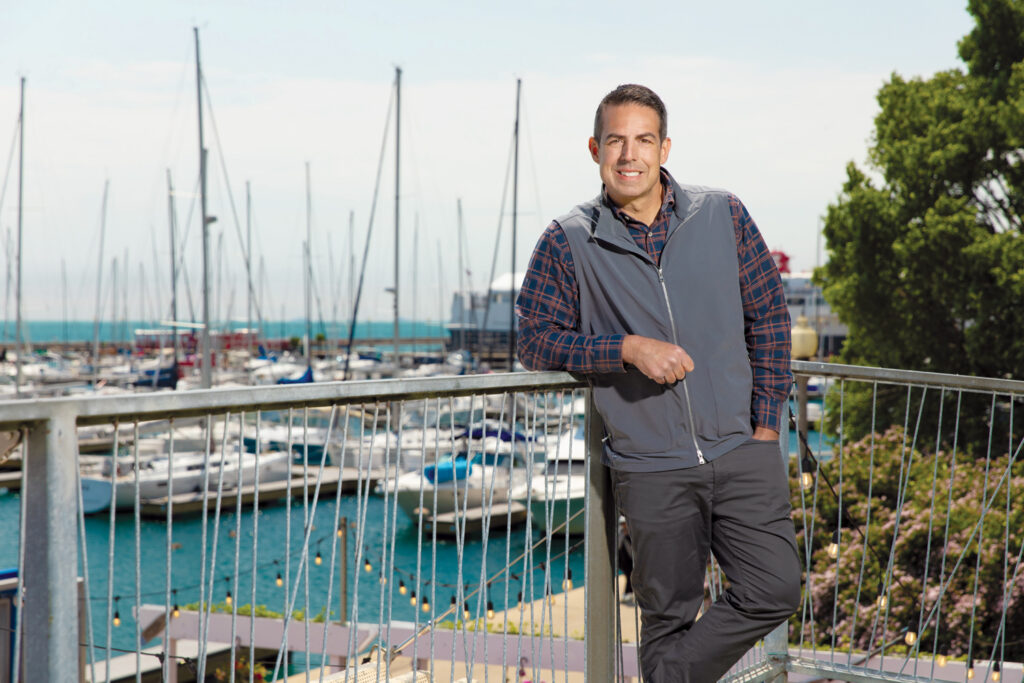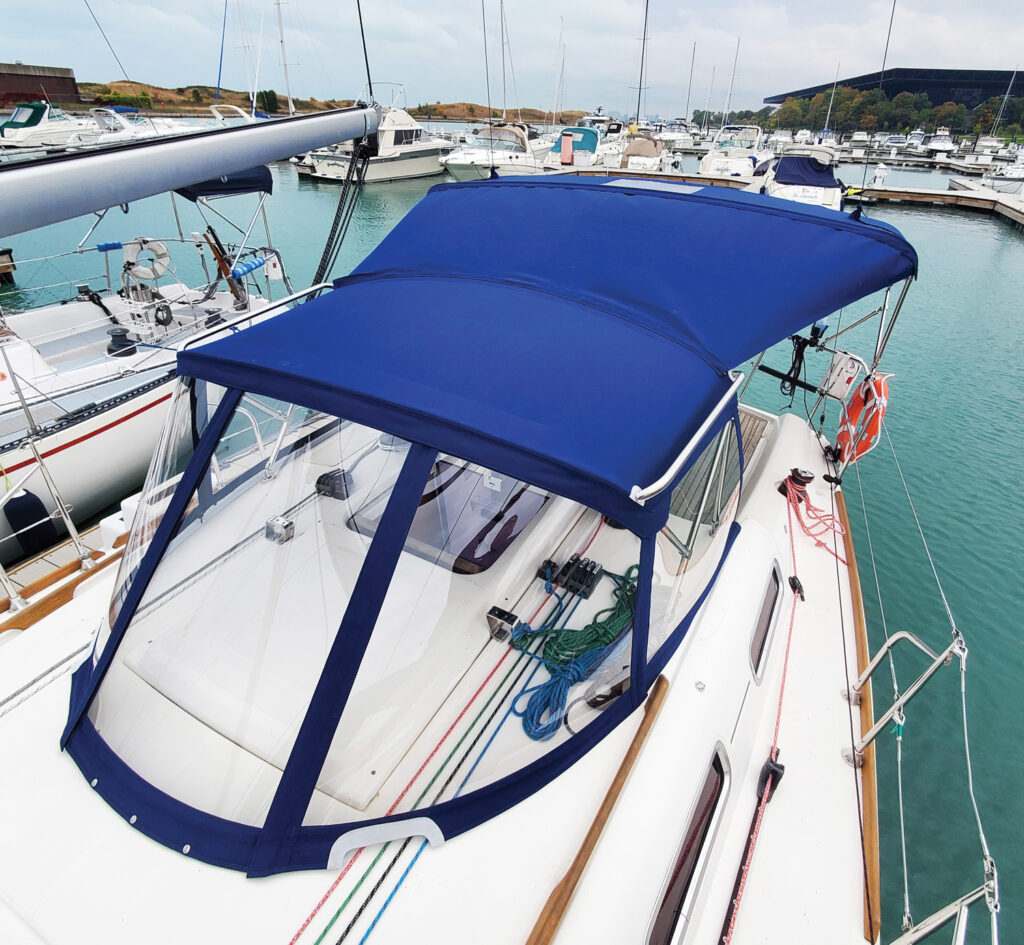Chicago Marine Canvas had the honor of being featured in Specialty Fabrics Review July 2024 issue. You can read the whole article by clicking the following link: Boats and beyond: Vince Innocenzi’s Chicago Marine Canvas – Specialty Fabrics Review. Alternatively, we’ve also attached a copy of the publication below.
Moreover, we want to thank the Advanced Textiles Association and Organic Headshots located in Chicago, IL for making this possible. It was a delight to work with Organic Headshots and their team of highly professional and talented individuals.
Vince Innocenzi’s Chicago Marine Canvas takes a digital-first approach to marine coverings and more.
Features, Perspective | July 1, 2024 | By: Joanna Werch Takes

Vince Innocenzi’s Chicago Marine Canvas business started with a coincidence. A boat owner himself, he noticed that the boat in a neighboring slip at the marina had been uncovered for months. At the time, he was working as a banker, with a side business importing patio furniture and selling it online. He also was starting to offer custom cushions for the patio furniture.
“I wasn’t really thinking about boats,” Innocenzi recalls, “and then I ran into the other boat owner. He said he couldn’t get anyone to come out, and I thought, ‘Why don’t we try to do a boat cover?’ It just kind of snowballed from there.”
 That was in 2018. Since then, Chicago Marine Canvas has outgrown three locations and expanded its staff. He closed the patio furniture business after selling all of its inventory during the pandemic. He quit banking and now works full time at Chicago Marine Canvas.
That was in 2018. Since then, Chicago Marine Canvas has outgrown three locations and expanded its staff. He closed the patio furniture business after selling all of its inventory during the pandemic. He quit banking and now works full time at Chicago Marine Canvas.
In addition to Innocenzi, current staff consists of an upholsterer, a field technician/installer, an office manager and a sewing team of four people that includes a manager. Of the offices located eight blocks west of Chicago’s Wrigley Field, he says, “It’s nice being in that metropolitan setting where you draw on a few different resources for hiring.” He has hired graduates of Chicago’s fashion schools for a year or two before they move on to their dream jobs as well as immigrants skilled in sewing and knowledgeable about the work’s digital aspects.
Straight into Digital
“Most people in this industry will learn a pattern by hand—paper, plastic, whatever method they use—but I jumped straight into doing it digitally,” he says. He creates his patterns using computer-aided design (CAD) software. For pattern transfer, he says, “The first automated table we had to actually put the pattern on the fabric was just a plotter, so it just drew lines on the fabric and then we would cut it with scissors or a hot knife, depending on the material.”
A landing gear and engine covers project for United Airlines that used a total of 4,000 yards of material led to switching the plotter for a plotter/cutter option. “Then, when we moved to our present location, I actually found another automated table through an auction that I got a notification of through the ATA,” he says. “We went out to Pennsylvania, disassembled the machine, took it all apart in a day, loaded it onto a truck, brought it back to our shop and put it all together ourselves. And magically, it worked. So right now, we have two automated tables when it comes to cutting.”
Innocenzi and his field technician measure dimensions for boat covers and most other projects with a Proliner portable measuring tool made by Prodim of Fort Pierce, Fla. However, reupholstering existing seat cushions with new vinyl is more challenging to measure digitally, “so that is something that we still hand pattern,” Innocenzi says. “So we still kind of do some things manually, but I would say 90% is through that automated process.”

Beyond boats
Chicago Marine Canvas also makes things other than boat covers, including residential outdoor covers for grilling areas and patio enclosures. Expanding beyond marine projects, he says, offers the opportunity to even out workflow throughout the year. “Anywhere outside of where it’s warm year-round, you struggle in the wintertime. It’s always been kind of a puzzle for me: I want to increase staff for the summer to keep up with demand, but I don’t want to lay people off in the wintertime. So we have to get creative with what we do.”
Last year, for example, the company made 18,000 heavy-duty tote bags the state of Illinois used to collect gravel from quarries to test for use in concrete road construction. Chicago Marine Canvas also made canvas frames with isinglass windows to shelter drivers of electric bicycles that tow cargo holds. It also welded the frames for those canvas covers.
“People call us when they can’t find anyone else to do it,” Innocenzi says, citing a project for Hormel Foods. “They have X-ray machines that the packaged food goes through to make sure there’s no contaminants, and those X-ray machines are north of $100,000. So they had us come out and make custom covers for all of these machines because overnight, they’ll wash everything down with different cleaning solutions, and they don’t want the machines to get damaged.”
In addition to canvas projects, upholstery and flooring, Chicago Marine Canvas bends aluminum tubing to support the framing of bimini tops and dodgers and welds aluminum for rigid structures. “We’re using social media now to get the word out that we don’t just make boat covers. We do more than just one thing,” he says. “I would like to think everyone knows everything we do, but they ultimately don’t.”
Social, word-of-mouth marketing
A calendar of Facebook and Instagram topics determined at the beginning of the year highlights various projects. For example, spring discussions might focus on bow pads for the front of the boat because people like to enjoy the outdoors during the summer. “In the fall,” he says, “we’ll start talking about winter covers, maybe some more residential projects of covering outside kitchen areas or grills.”
Innocenzi says his most successful marketing comes through word of mouth on the docks. “One boat owner’s happy with our project, they’ll speak to all their neighbors, or neighbors will see they got new canvas or new upholstery.”
He’s particularly proud of a dodger and bimini top project that received an Outstanding Achievement award in the Marine Fabricators Association 2024 Fabrication Excellence Awards. A sailboat charter owner wanted a wider bimini top to offer more shade and an elongated dodger to provide both comfort and a secure space to keep his dog from falling overboard. (See sidebar.)
Innocenzi says, “The nice thing about doing the designs in the digital world was we were able to take preliminary measurements of the boat and send [the client] a rendering of what the new canvas and framing would look like” in advance of fabrication.
Innocenzi’s pride in that project and others extends to aesthetics. He says, “I think that what makes this industry unique is that you want to protect the boat and its occupants, but there’s also an artistic aspect of it where you want to make it look beautiful.”
Joanna Werch Takes is a freelance writer and editor based in Minnesota.
SIDEBAR: Project Snapshot

Purposeful pet space
Vince Innocenzi is particularly proud of the project “Woody Wants a New Dodger,” which received an Outstanding Achievement award in the Marine Fabricators Association 2024 Fabrication Excellence Awards. Woody is the name of the dog of the commissioning charter sailboat owner.
“[The client] was moving the rigging around when he had guests on board to actually sail the boat,” Innocenzi explains. “So, the existing frame he had would not work, and he wanted to expand the dodgers so his dog could fit on the boat in a comfortable area and not possibly fall overboard.”

Chicago Marine Canvas elongated the dodgers on more than one of the charter company’s boats, moving them forward and remaking them “in a way that looks really nice, but it’s more secure also,” Innocenzi says. The team also widened the bimini tops to provide more shade.
Using a digital design process, Chicago Marine Canvas took preliminary measurements and sent the boat owner a rendering of the new canvas and framing before manufacturing anything. Innocenzi says, “We went back and forth a couple of times on the design and kind of narrowed things down so everything was exactly how he wanted it. It was a real nice process flow, start to finish.”
SIDEBAR: Q&A
What is your business philosophy?
Always do what’s right for the customer. We rarely turn down a request. A customer just bought a 46-foot boat. He sold his 24-foot boat that we did a great job on the cover for a few years ago. He was happy with a small project back then, and it’s exponentially larger now. I know that if we go the extra mile on one project, it’ll pay out tenfold once we get referrals.

